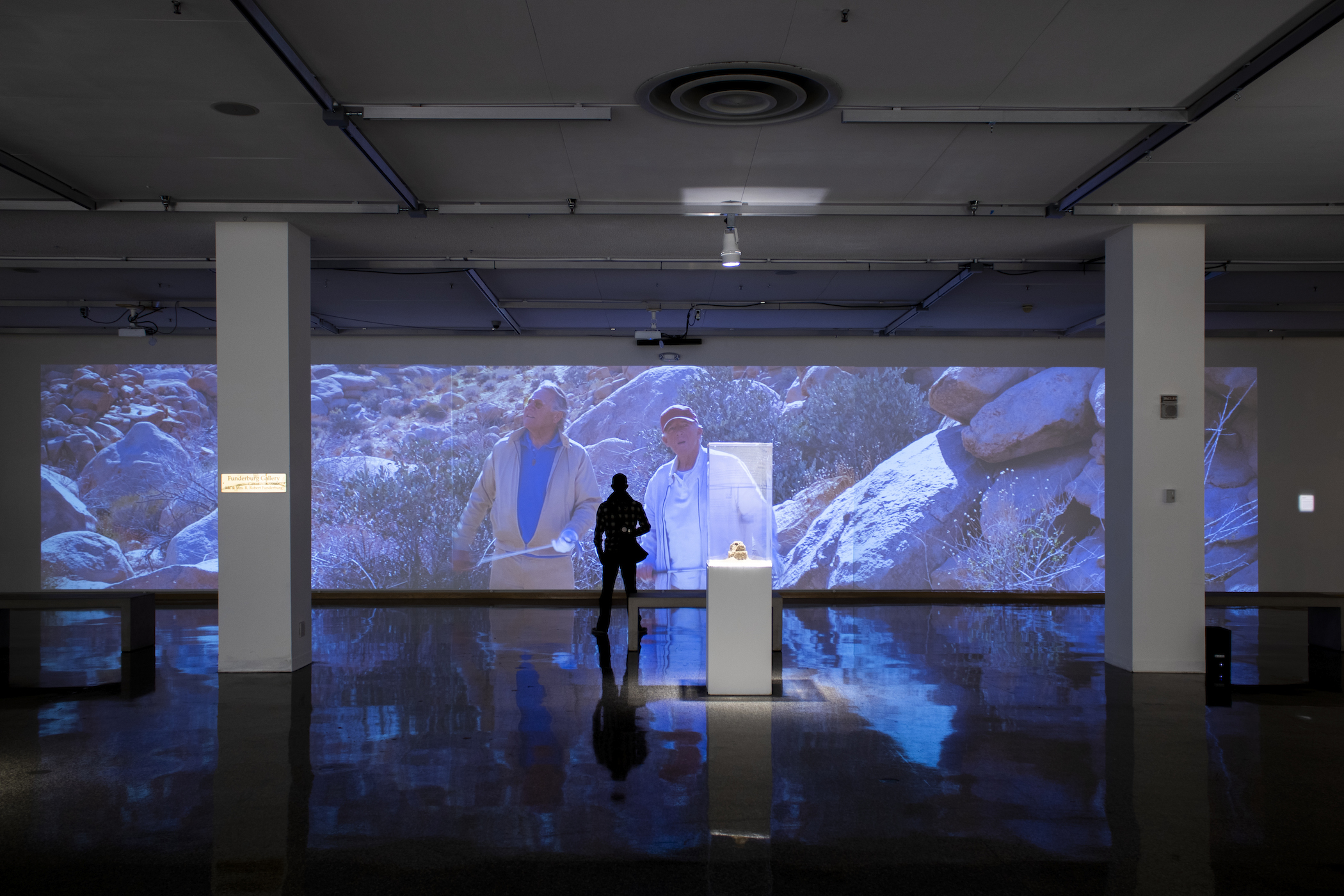Jonah King’s solo exhibition, How the West was Won, at the Rockford Art Museum is curated by Jason Judd and Puchalska, as New Genres Art Space. Through video installations, sculptures, flags, a wall installation, and an overall aesthetic reminiscent of a history museum display, King uses golf as subject and metaphor to reveal intersections between colonialism, climate change, and oppression. Aziz and Farcus recorded and transcribed a conversation about King’s exhibition. The discussion has been edited by the authors for clarity.
Adam Farcus: Why golf? I felt like Jonah King (he/they) picked golf because it’s about claiming space. Golf courses are places that are only for pleasure, not living or sustenance, and when the course isn’t used for pleasure you don’t do anything with it except pay for it to get taken care of. That, to me, feels like a perverse form of imperialism.
Sarah Aziz: Yeah, and what I think the big distinction is, what you’ve described could be applied to parks or other spaces of recreation that are designed specifically for pleasure. But ultimately the issue for me is the exclusivity of golf, because it’s not just about claiming land and giving it this singular purpose, it’s also about creating barriers to entry–marking out who has access to that space versus who doesn’t. It is interesting that King made this video in a landscape that is synonymous with the American West. It’s desolate, and there are no hard edges. It is the antithesis of what golf is.
AF: It doesn’t work–they’re trying to play the game and it doesn’t work. Is that what you mean?
SA: No, I think the game functions–it’s more that he is subverting the logic of golf. I don’t think that disrupts the game, I think it is a larger commentary on the settler/colonial narrative of space and place, which is about money and division. By directing the two men to play golf in the American West – in a place that isn’t conducive to the game – it highlights all of the problems of golf and colonial mentality that we’re slowly confronting more now.
AF: I thought playing golf in the desert points to the absurdity of the act of claiming space.
SA: Yeah.
AF: And it has happened in so many places. Golf has been spread everywhere that the UK has colonized: South Africa, the States, India, etc.
In the joke video [OK BOOMER (The Good News is He Thinks I’m God)], when they’re telling dad jokes between each other, those jokes humanize them and complicates the way we seem them elsewhere in the exhibition: in the timeline (History of Golf) and in the video of them playing golf (How the West was Won), when they’re seen as agents of the imperialistic act of playing golf. There is even a dad joke about how there is even golf in heaven. In the joke two golfers make a pact that if one of them dies that he has to come back and tell the other if there is golf in heaven. One of them dies comes back to tell his friend, “Yeah, there is golf in heaven and you’re up soon.” That imperialism is even up in heaven.
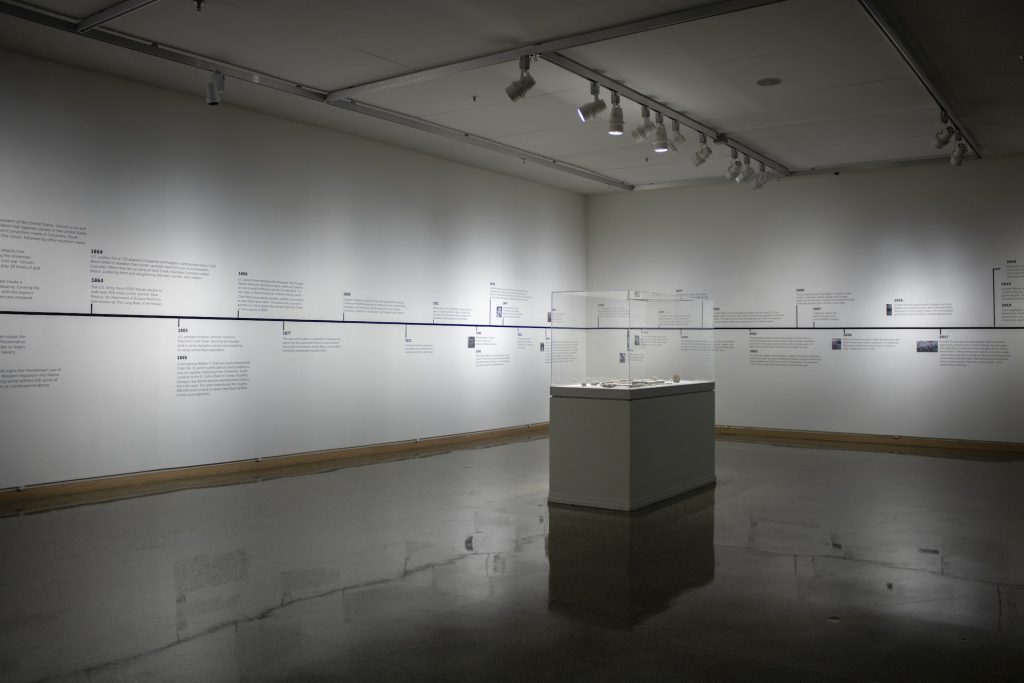
SA: That reminds me of a moment in the timeline: in 1611 “King James I commissions a new English translation of the Bible…” and there are a few adaptations made to some passages, one of which being with “Genesis 1:26-28: ‘And God blessed them, and God said unto them, Be fruitful, and multiply and replenish the Earth, and subdue it: and have domination over the fish and the sea, over the fowl of the air, and over every living thing that moveth upon the Earth.’”
It speaks to that deep and problematic belief system through which land and everything it contains is subservient to man. Not just to man in particular, but the category of man as well. As someone who is not from this country and isn’t embroiled in golf culture, the times the sport has entered into my consciousness has been around the topic of power structures. Golf is almost always about males going to conduct business deals in this really banal, innocuous, lighthearted way. The golf course is this arena through which the world is changed by the select few, and a powerful space for the 1% to negotiate. To think about exercising power on that level, and all of the bounties and riches that come from those exchanges – of course it makes sense that heaven has golf because when we think about the holy divine powers at play in heaven there are parallels that can be drawn between divine powers and the men with power.
AF: When you were talking about power and the decisions that are made on the golf course, it made me think about who is allowed within the border of the course. US presidents use the golf course as a place where political work can get done – the president will invite people to play who they want to negotiate or make deals with. The timeline also points to who’s included and who’s not by highlighting golf’s history of racial exclusion and connections to the KKK.
SA: To that point, one of the last few pieces of the timeline speaks to Donald Trump’s deep ties to the sport. “During his time in office, Donald Trump spent an estimated $140,000,000 of taxpayer money on golf.” Preceding that there is all of this racial tumult centered around the act of golf. The KKK supported certain golf courses, clubs advocated for excluding non-white members, and in 2008 Golfweek published a magazine cover with a picture of a noose on it, with the caption “caught in a noose,” in response to Tiger Woods earning the world champion title.
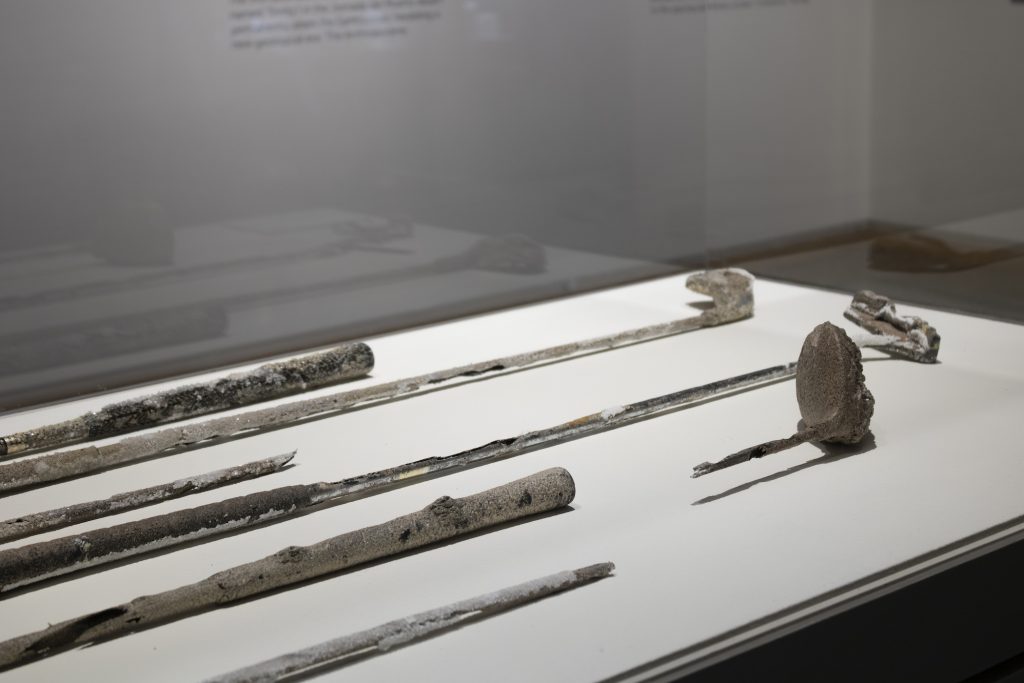
One thing I really appreciate about King’s work is that they are making all of these moves centered around the stretching and compressing of time, and then contrasting that with a really clear time frame. It made me feel like I was walking through multiple planes simultaneously where I could peer into different moments in history. So, when you’re thinking about archeological artifacts in the future and how they’ve disintegrated [Ritual Weaponry], and then you look beyond them and see the noose, in that moment you’re trying to understand all this contentious history at once.
AF: It is the contentious history and march of colonization. The reference in the movie, How the West was Won (Ford, Hathaway, & Marshal, 1962), is Westward Expansion. The narration at the beginning of the film says that settlers were winning land “from nature and primitive man.” It is seen as the white man’s prerogative, like “of course, this is here for us and I’m here to claim it.” The film starts with that trapper going west because he is there to take whatever he needs.
SA: I was surprised by that beginning of the film because I think the most poignant narrative of European settlers is that they never took just what they needed, they always took more.
AF: Right. The film romanticizes all those actions and casts them in a positive light, but even someone who is coming just to take what he needs is taking things that aren’t his.
The whole timeline is cherry-picked in a way that’s not just a linear history of golf the sport, but also a timeline of imperialism, colonization, golf, racism, the two actors in King’s videos, and the ways that these things coalesce around Trump. In the timeline it says that both of the actors voted for Trump – this makes me see the red hat the one golfer is wearing in the video as a MAGA hat, even though it doesn’t have MAKE AMERICA GREAT AGAIN written on it. It’s hard to not to see that sign as anything other than Trump and what he stands for – especially on top of the head of a Trump supporter. For me, those two actors then are proxy, in the desert, for this imperial force that caries the same ideologies as Donald Trump.
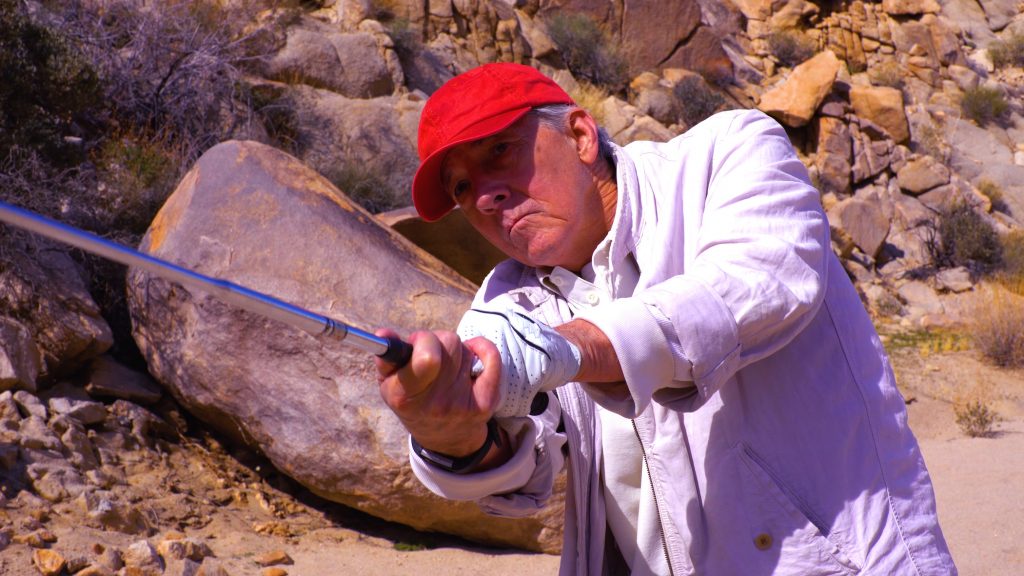
SA: I see where you’re coming from, but I felt like King was presenting us with a different perspective; of two men who are anxious about the shifting and uncertain nature of their demographic. This is a fraught argument to say–the golfers’ cheery disposition or lightheartedness in the video is about their unwavering determination to play golf in a place that’s not suited to facilitate the game. I think it’s something a little bit more innocent. There’s a disjuncture between Trump and all of the truly nefarious things that he stands for, versus these two people whose identities are based around this game. My reading of them was that this is a world they inherited, although it doesn’t mean that it’s okay. I’m clearly speculating, but for me I got the sense that this is all that they know, this is the world that they care about and it’s removed slightly from the history that we were exposed to–
AF: –In the exhibition?
SA: From watching the videos in the exhibition I thought that these are just two men, this is their world, and they desperately want to preserve it. I don’t see them and Trump as one.
AF: Okay.
SA: I can understand why you can see them as one, but I just don’t find them to be as problematic as Trump. They’re not carrying all that baggage. They’re focused on playing the game. There’s silence, there are no political negotiations taking place, all they cared about was the craft of the game. Which is different than what we spoke about.
AF: How do you square the exhibition narrative, or the framing, of this long and complicated history? King makes golf more complicated than just a game. I don’t think you’re saying the golfers are naive but that it’s almost like they have stepped outside of the history and context because they’re only invested in the sport.
SA: I really think King is trying to make sense of this place and this uniquely American phenomenon. The only way that you can understand something is by looking at it in its totality, and that’s all King is doing. They’re trying to piece it together through observation. And then they’re processing the information, rearticulating it, and establishing their own connections. It is like a snapshot into King’s brain. They draw parallels between bits of information that they’re finding. So, there’s a sincerity and earnestness that comes across in the golfers.
AF: I’m with you on that idea in regards to the golf game video, and I think it’s even moreso present in the dad jokes video because they’re super lighthearted. Maybe when I said the golfers were a proxy of Trump, perhaps it’s not so much of a one-to-one. The golfers aren’t Trump and we don’t see them perpetuating all of those racist ideas that are in the timeline, but I don’t know that they’re also not not there.
SA: Yeah.
AF: I think of the things on the exterior of the exhibition–the timeline, the large video, the dad jokes, and the flags – are a look at the past. And then all the objects in the middle–the sand castles and the golf club fossils (which are presented as weapons or tools) are a possible future…something from an archaeological dig. I think framing these “fossils” as weapons or tools points toward the continuation of that violent colonial ideology that’s in the timeline. I mean to say that these two men aren’t the KKK, as it was mentioned in the timeline, but I also think that in their support for Trump there’s an unexpressed continuation of a lot of those things.
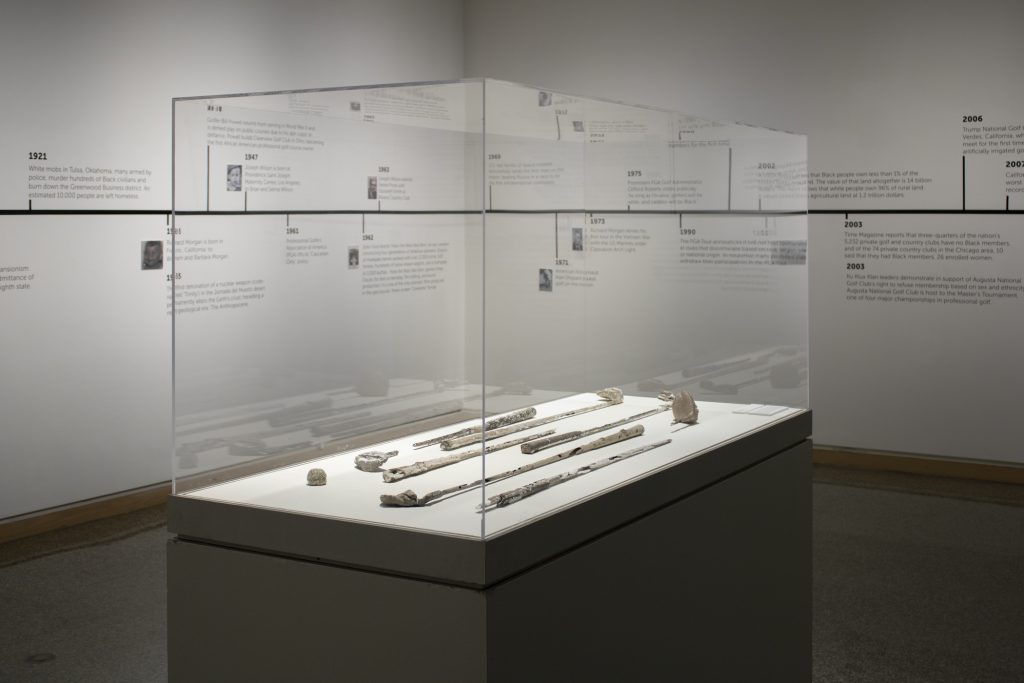
SA: I totally agree with that. There are different levels of potency for all of these different histories that we encounter in the show, and the two men playing golf are just a very diluted version of the things that we see in the timeline–this is the history that they’ve inherited, and they still perpetuate it, but maybe without the same malice or intent as their predecessors did. By participating in the sport and not fully engaging the larger questions that it raises they’re complicit–I get it.
I also felt a slight sadness when I was watching them play golf, not because the futility of the sport in this landscape, but because in this era of rapid social change that we’re in we are trying to remove golf because it’s so fraught and problematic. I sort of see them with horse blinders on and unwilling to acknowledge the negative associations or the dangerous role that golf has played and how it continues to be weaponized. They just want to play the game. Even on a lunar-like landscape, it doesn’t matter.
AF: Right, we can’t cancel somebody’s identity because we’re not going to resolve systemic racism in the States by calling people racist. I think that’s part of what you’re saying. I think though, for me, what feels really like a turning point in understanding the exhibition is where it’s noted in the timeline that those two golfers voted for Trump. I have a hard time squaring the idea of the support for somebody who’s racist as something you can have blinders on for. I think the question is: are you practicing racism, or are you a racist person, if you support racist people? And following behind all that is the history that’s presented in the timeline and the fallen empires.
SA: It’s hard, because if I think about the golfers–and I’m obviously assuming a great deal because we don’t know anything about them other than these small snapshots that have been carefully curated by King–the question is more like: what is left out when you’re focused on a very particular need? If what they hear from Trump is that he is fighting to maintain golf courses–the thing they care about deeply–do they hear anything else? Also, we don’t believe in everything that Biden does, right?
AF: No. That’s a good point. We know these two men like golf, they know dad jokes, they voted for Trump, we know when and where they were born, one of them served in the military…and maybe they voted for Trump because of faith or any reason. Without knowing motivations, we have to fall back on ourselves. It’s my ideologies that I’m thinking about–
SA: Yeah.
AF: –and my judgment of people who voted for Trump.
SA: I think exhibitions like King’s ask us to challenge our assumptions, because if we fall back into them then we just perpetuate all of the things that we’re accusing the other side of and we’re never going to heal any kind of division.
AF: Yeah.
SA: This is why I’m being a bit defensive of them because we can’t always assume that the other side is always repeating the totality of a given ideological framework. There are so many different ways to engage with the sport that can be divorced from its baggage but you can absolutely repeat and amplify that baggage. King presented these ideas in the former way–it was more about two people who have Republican tendencies that are truly enamored by golf: a sport that is intertwined with Republican practices.
I don’t know King or their experience growing up in Ireland, but as someone who’s from the UK, I know that we have huge racial tensions and there are all kinds of conflicts with identity, but not to the extent that they are in America. Things don’t seem as binary as they are here and I think that’s one thing I struggle with a lot: how everything is not that black and white. From a British perspective, there’s an ability to look beyond identity and understand that people are just human–even if for a moment–and I don’t see that here in the States as much. When I saw King’s work, I saw an immigrant trying to make sense of the world that they’re in. It’s not as black and white as the golfers being Trump supporters or not–it’s just two people who really like something and there’s a grey area between the politic of golf and the practice of it.
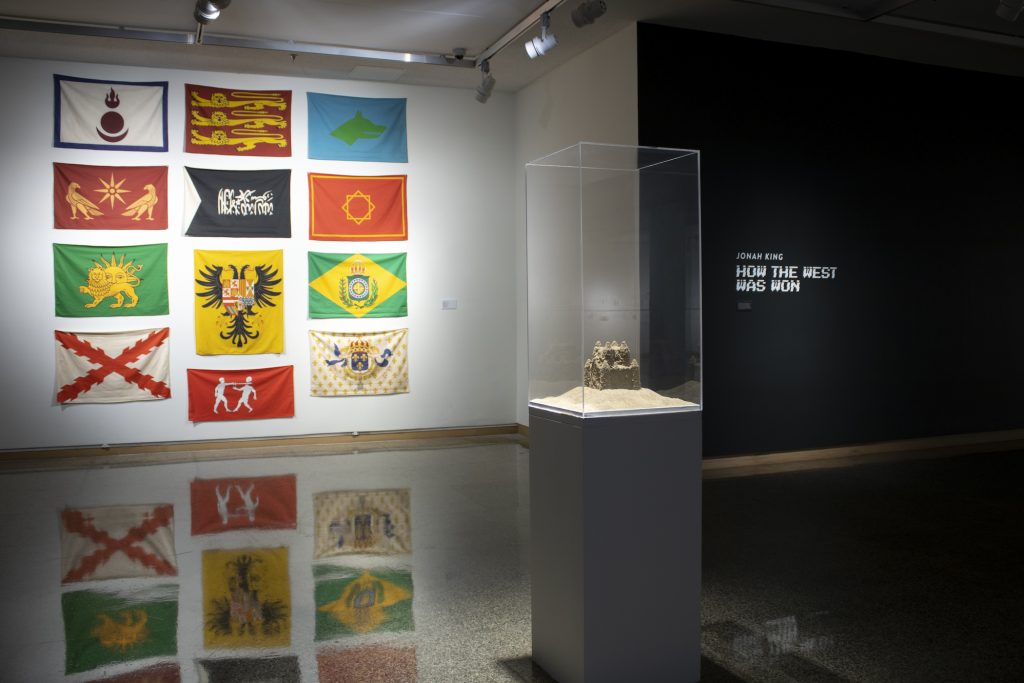
AF: I see what you’re saying in the humanizing-ness of the dad jokes video because the jokes are so disarming in one way, even though they do also repeat some complicated ideological issues in another way, but the action of them playing golf in the desert feels different and seems like an absurd gesture. I said that it could be seen as an act of trying to claim or colonize more space, but I doubt that now because they’re definitely struggling to play and it’s not working. The landscape in the video is really beautiful but also super desolate–it matches the aesthetic of the golf club fossils, which makes the colonial ideology kind of neutered and pathetic.
SA: But another way to think about it is that when, as immigrants, you come to a new place you try to make it work as best as possible. I think in “trying to make it work” you draw on your history and memories and you build a new perceptual experience that’s overlaid onto the environment that you’re in. Meaning, you can look at an environment but what you see is your version of that reality. I think there’s some power and agency in what they were doing. If this is a game they love and something that’s familiar, then it doesn’t matter if it’s a swamp, it doesn’t matter if it was on the Atlantic, because the goal is that remarkable perseverance, resilience, and willingness to just play and make it work. I’m not disagreeing, I’m just saying there are two sides to the thing. This speaks back to the film (How the West was Won) and these narratives–
AF: The imperial and colonization narratives?
SA: –not necessarily imperialization, I mean it came from that, but a determination in someone from a different land to make some new place work. That’s not about slaughtering the people who are there, I don’t mean that whatsoever, I mean the adventure that’s embedded within that journey. For the golfers, it’s the adventure, inventiveness, and everything that came along with them playing golf in this new place.
AF: That leads me to the act of playing golf in the Californian desert, is more of a simulacrum–it’s a play or farce on the idea of Westward Expansion and colonization, but that is not necessarily oppressive. It’s not oppressive like it was in the history of golf.
SA: I think the nice thing about that thought is that all of the oppression is on the edges of the exhibition–so you can never escape it. In watching the videos there are moments of reprieve when you realize the other side of an ideological conversation is sometimes neglected. That’s a nice thing about this exhibition, everything is intertwined. King allows us to dip in and out of narratives and histories because of the way that they play with time, character, and juxtapositions. We can think of these people as doubles of Trump or we can think of them as with just innocent people who have inherited a particular worldview but don’t acknowledge its full extent. I think what you’re saying about Westward Expansion without the oppression is really interesting, but then all of the oppression is just spilling out on the wall.
How the West was Won is on view at the Rockford Art Museum through May 31, 2021. A virtual version of some of the elements in the exhibition, including How the West was Won, OK BOOMER (The Good News is He Thinks I’m God), and The History of Golf, can be viewed at: http://historyofgolf.jonahking.info
Featured Image: Jonah King, How the West was Won, 2018, 3-channel 4K video installation view at Rockford Art Museum. An installation photograph shot from a far distance. A person stands in front of the video projected onto the back wall and in the middle of the image a spotlight illuminates a vitrine with a small sculpture inside. The video projection is nearly as tall as the museum wall, the width is five times as it is tall, and features two golfers looking quizzically around in a rocky and hilly landscape. The video is reflected in the dark-colored and shiny floor. Photograph by Jason Judd.

Sarah Aziz is the 2020-21 Innovation in Design Fellow, in the School of Architecture and Urban Planning, at the University of Wisconsin-Milwaukee. She earned an interdisciplinary Masters of Architecture degree from the School of the Art Institute of Chicago. Aziz’s website is sarahaziz.com.
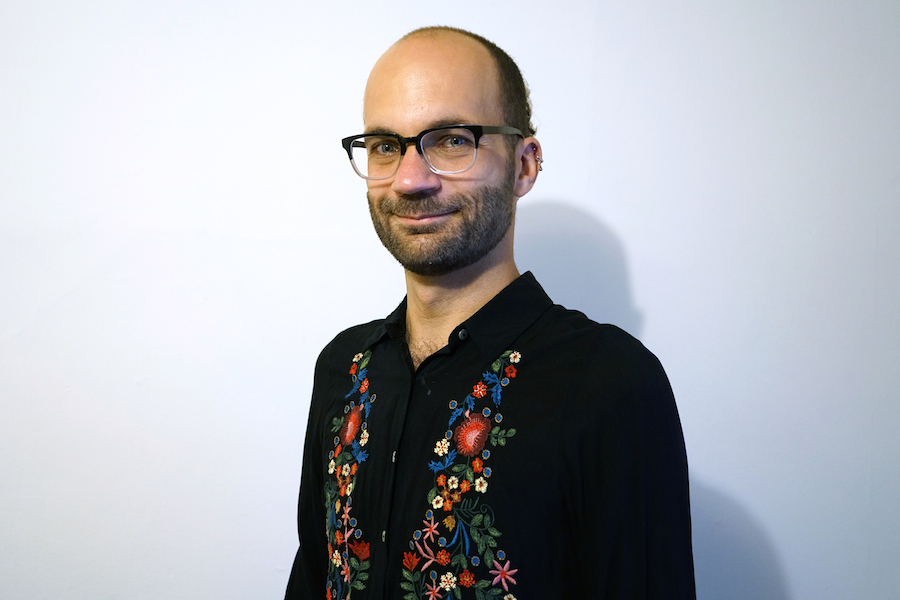
Adam Farcus is a Milwaukee-based activist, artist, curator, feminist, teacher, and writer. They direct the nomadic curatorial project, Lease Agreement, and are adjunct faculty in First-Year Experience at the Milwaukee Institute of Art and Design. Farcus’s website is adamfarcus.com.
